You might have heard the name as belonging to a man famous for carrying a bow into battle in WWII, but who was he? Hugh Soar reveals the archer underneath the reputation
John Malcolm Thorpe Fleming Churchill was born on 16 September in 1906. Although there were many facets to his character, and he was a romantic and sensitive man, he will forever be remembered as a leader of men in battle. Known to posterity as ‘Mad Jack’, through his swashbuckling, sword-wielding style of fighting and the charisma which permeated his outstanding military career, it was a role he performed to perfection.
He was never a man to be hindered by convention or overawed by it – on one occasion he appeared on parade at Sandhurst Military Academy carrying an umbrella: asked in no uncertain terms by bristling authority why, he replied succinctly, “Because it’s raining!”
He acquired his commission in 1927 and served in both Burma and India for many years where, inbetween varied exploits, he was taught by the Pipe Major of the Cameron Highlanders to play the bagpipes. He learned quickly and played well, later entertaining with his skill, and achieving distinction as the only Englishman to obtain a medal at a piping contest. Disenchanted with military service he left in 1937, to be recalled two years later. Although bearing a quintessential English name, Churchill felt an affinity with Scotland and the Scots and it was his wish to command a Scottish Regiment, a wish which later, in Palestine, he ultimately if only partially achieved.
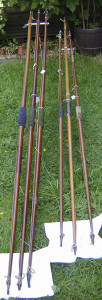 But, we move too fast. For this piece is about Churchill as an archer. Much has been written about his military exploits with the bow – some drawing heavily on imagination – and although there is speculation by some about the bow he used since he possessed a steel weapon, he did indeed hit a German with a hunting arrow during the withdrawal to Dunkirk in 1940. However, since he had instructed his men to open rapid fire as he shot, without wishing to spoil a good story it may well have been a rifle shot that finished the chap.
But, we move too fast. For this piece is about Churchill as an archer. Much has been written about his military exploits with the bow – some drawing heavily on imagination – and although there is speculation by some about the bow he used since he possessed a steel weapon, he did indeed hit a German with a hunting arrow during the withdrawal to Dunkirk in 1940. However, since he had instructed his men to open rapid fire as he shot, without wishing to spoil a good story it may well have been a rifle shot that finished the chap.
While Jack evidently enjoyed shooting the traditional English longbow and possessed several – a number of which are illustrated, and detailed here – he was also forward-looking and used the newly introduced steel bow, made by See Fabriks Aktieborg Sandwigen, Sweden, and marketed as ‘Seefab’. A practical item, it first became available in Britain during the summer of 1935 when within an edition of Archery News it was introduced to an initially sceptical archery public.
It is uncertain just how many men’s heavy bows Jack actually had. George Sorrell, the last indentured bow-maker of the twentieth century records having made him one of 100lbs draw weight, he says for a specific purpose, although what that might have been is not defined, while bowyer Harry Purle is said to have made him two others, each of 80lbs.
Although he undoubtedly shot earlier, Jack’s serious competitive archery began with the Royal Toxophilite Society, to which he was elected in 1939. He was a very active member and took part in events for the Society’s trophies and awards from April onwards, contesting then for the ‘Norton Cup’ (144 arrows at 60 yards), making 591 with 117 hits and 18 golds. He came sixth of 17 shooting.
May was a busy month. On 6 May he shot a ‘Short International Round’ making 271 with 64 hits and coming third of 11 shooting. Speculatively here he may have used a ‘Seefab’ bow. On 11 May, he tried a York Round, but was absent for the 100-yard distance. A Hereford followed on the 13 May, when he scored 302 with four golds and 82 hits.
17 May saw another York, this time shot more successfully with 73 hits, 329 scored and four golds – and Jack came second of eight; he gained a medal for best gold at this meeting. An ‘American Round’ followed on 20 May with 73 hits, scoring 325 with 12 golds. Jack competed both nationally and internationally. In April 1939 he had attended the prestigious ‘Ranelagh Meeting’ shooting a Double York to score a respectable 600 with 136 hits and 11 golds while June saw him at the seventy-sixth Leamington and Midland Counties Meeting, again shooting a Double York, scoring 425 with 102 hits and 6 golds. Curiously, at this meeting his club is recorded as ‘Buckingham’, not Royal Tox.
Ever one for innovation, he also took part in a ‘Short Distances Postal Competition’ held during the week of June 11-18 1939. The two shorter of the ‘International Round’ distances, 35 and 25 metres, were shot; for the two distances his score totalled 183. In August he shot in the thirty-first Southern Counties Meeting held at the Imperial College, Windsor, where at a Double York he made 131 hits for 525 scored with eight golds; one of which, at 100 yards, gained him a medal.
In September he moved on to the international scene when he took part in the ‘International Archery Championship Meeting’ held at the Bislet Stadium in Oslo between 31 July and 5 August. It is now well-known that he led the English team into the Arena kilted, and in Scottish attire playing the bagpipes.
While a photograph of this impressive entrance appears within the official account, that chosen by staid authority to record the English team omits both him and the bagpipes. With war evidently imminent and his recall to the army Jack may have had other matters on his mind, for his scores belie his proven abilities. He came 26th overall of 37, and sixth of the nine-strong English men’s team. For the Long Distance event his scores were: 90 m 209; 70m 224; 50m 189; totalling 622, and for the Short Distance: 50m 209; 35m 238; 25m 113. His total overall was 1182.
Jack collected bows, and so his choice for competitions is speculative. We know he used a steel ‘Seefab’ bow at the Oslo Meeting, perhaps reserving a wooden bow (or bows) for the British rounds. Of his three self-yew men’s bows, one by Aldred may not have been used at all. It has a label secured to its upper limb indicating a gift in 1933 from a John Yates, perhaps a fellow archer. It is 72 inches in length and is of 40lbs draw weight. Although cracked, the damage has been hidden by tightly bound and varnished thread.
The remaining two are by Aldred; one is 72 inches long and of 48lbs draw weight, the other is 69 inches in length and 47lbs. Men’s bows by this maker are generally of 72 inches, and this suggests a custom-made item since shorter bows made to order by Aldred are known – a 69-inch example made for national champion C.J. Longman is in the writer’s collection. As is customary with bows of self yew, each has an arrow pass in mother-of-pearl. One bow of self-lancewood with no maker’s name inscribed, has the mark PB 75 on the belly above the handle. If PB does not indicate ‘Point Blank’, as it often does, then the mark is enigmatic.
Besides the men’s bows, he owned two ladies’ bows. Each is in self-yew, one by F.H. Ayres, 63½ inches in length and of 27lbs draw weight is missing its upper nock but otherwise is in good condition. The other, a rare example by Hezekiah Dixon of London, is 62 inches long and 30lbs; it is complete.
Jack possessed hunting arrows; however, he was sensitive to animals and I have no evidence of his hunting. There are five examples, and I know that others exist. Each has a 3/8 inch parallel, red-stained stele with a simple nock cut into the shaft; each is fletched with six-inch, deep cut white turkey feathers and is armed with a Howard Hill style barbed head. One blade is missing, with just the socket remaining attached to the shaft. These arrows are unlike anything available in UK at the time and there is a possibility that they were obtained from the USA. With them, when acquired, was one Ayres hunting arrow, similarly headed.
While I have no evidence of interest in Kyudo by Jack, with the collection was a well-made Japanese quiver, containing four target arrows. Both case and arrows are evidently old and probably of nineteenth century origin; acquired perhaps during his overseas service.
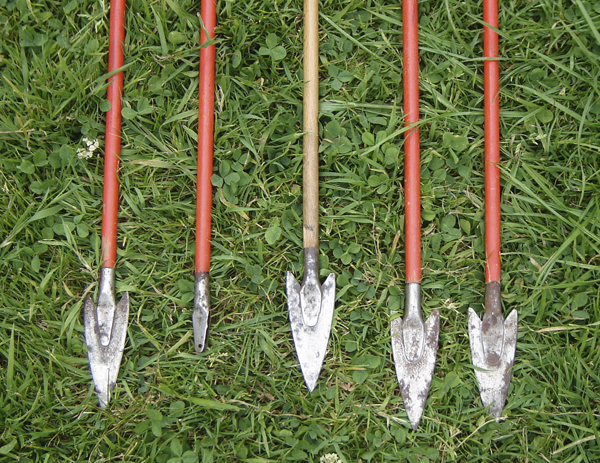
You can see one of the blades is missing on the arrow pictured second from left, with just the socket remaining
Jack’s archery interests were wide and varied, his flair for publicity sublimated by archery in a number of films including ‘The Thief of Baghdad’, ‘Sabu the Elephant Boy’, and ‘The Drum’ where he played his bagpipes. I believe his last appearance was at Warwick Castle in 1946 during the filming by Twentieth Century Fox of ‘Ivanhoe’.
Colonel J.M.T.F. Churchill, MC DSO & bar, soldier and bowman, was cast in the heroic model, truly inspiring those he commanded. He died aged 89 in 1996. We who survived the war owe him much.


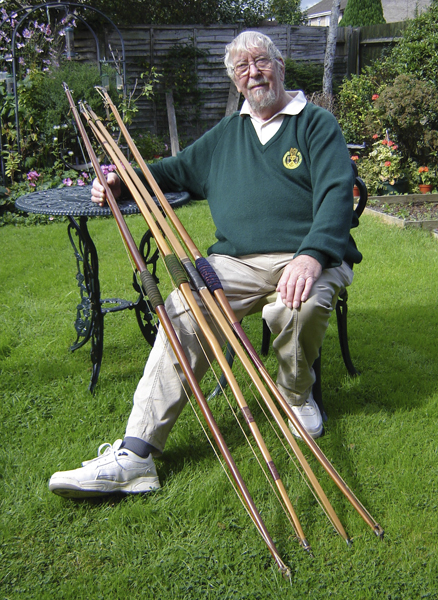
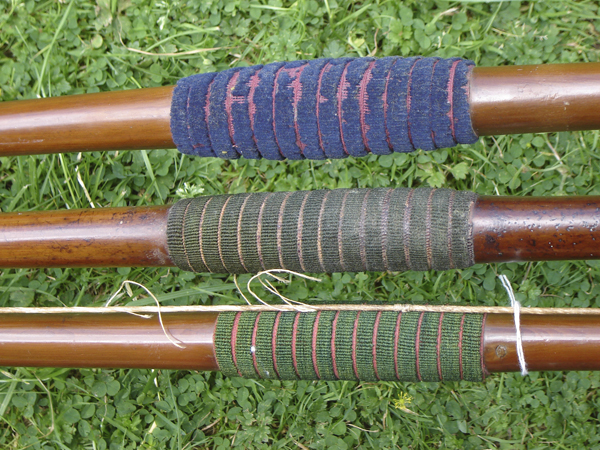
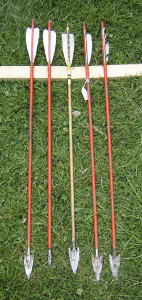
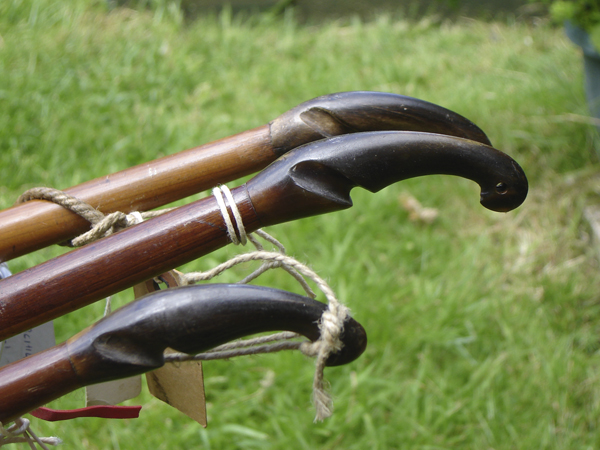
Just saw a video detailing this man’s life and heroics! He’s a true warrior and a true hero! It just goes to show that you can’t tell by looking at someone what their past was like. What a great man!!